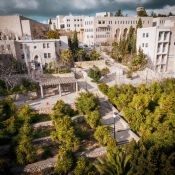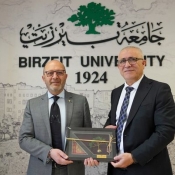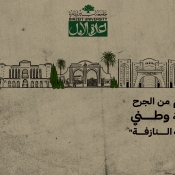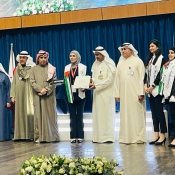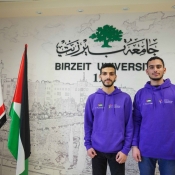What makes an eco-friendly campus? Birzeit University’s Bishara Abu Ghannam answers in a short interview
Today, June 5, is World Environment Day, a day in which the world celebrates preserving and protecting the environment. Birzeit University, however, celebrates protecting the environment 365 days a year through its eco-friendly, green campus.
In 2014, Birzeit University won first place at the 6th Environmental Management Contest, held in Saudi Arabia. The prize was awarded to the university for its efforts to integrate environmental management into its campus design and operations.
To find out more Birzeit University’s environmentally-sustainable campus, we sat down with Dr. Bishara Abu Ghannam, director of the university’s Engineering Office.
Q: What qualifies Birzeit University’s campus as eco-friendly?
Every part of Birzeit University’s campus utilizes green practices and measures designed to protect the environment, spur its growth, and lessen our environmental impact.
Take the university’s buildings, for example. They are insulated against heat, to decrease our energy consumption during summer and winter, and they’re insulated against noise, so that academic work can continue without interruption from the daily hustle and bustle going on throughout the campus.
We’ve reduced the noise pollution in classrooms and the main cafeteria by using sustainable materials, such as sponge under the tables or burlap plastered on the walls and ceiling, that act to soundproof and isolate rooms from each other.
We’ve also replaced the majority of the fluorescent lights in the buildings with eco-friendly LED lights that emit a brighter glow while using less energy.
Q: What about using eco-friendly materials in the construction of the buildings?
Palestinian stone, sourced from local quarries, was used in the construction of all of the buildings on the campus. The specific stone we used has a few characteristics that make it perfect for use on a green campus. It reflects heat, instead of absorbing it, and so it acts as the first line of defense, so to speak. We’ve also made ample use of glass in our building to provide natural illumination and a breath of fresh air in auditoriums and classrooms.
Additionally, we’ve recently completed installing a solar panel station on top of the Omar Aggad Engineering Building, bringing the total number of solar panels to five, which provide between 15 and 20 percent of the university’s energy needs.
Q: What sustainable practices does the campus employ?
There are recycling bins within each faculty. Not that we produce that much paper waste; we’ve had a paper-waste reduction policy in place for a few years now. In addition to that, we recycle rainwater and use it for irrigation purposes, and we recycle wastewater in the university’s wastewater management plant and reuse it in different parts of the campus.
Additionally, most of the university’s service cars run on battery power, and we hope to introduce a culture of battery-powered or hybrid cars to Palestine.
Q: What future projects do you have planned?
We are going to remodel the area next to the university’s western gate to make it more resemble the eastern gate. We’re going construct a retaining wall; plant trees, shrubberies, and bushes; and line them with rocks to create natural water channels for irrigation.
Our goal is to create natural gateways to the university’s main entrances, as well as outdoor gardens and sitting areas for students to relax and unwind, or study, while enjoying nature.
In the long run, we aim to power the university’s entire campus on sustainable, renewable energy. That is a massive undertaking, but I believe we have the crew, the skills, and the spirit to make it a reality.


